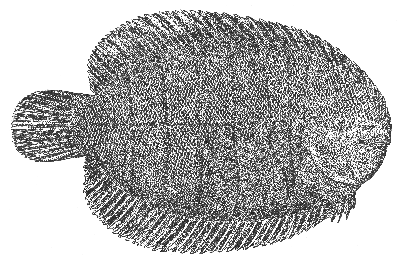Hogchoker Achirus fasciatus Lacépède 1803
AMERICAN SOLE
[Jordan and Evermann, 1896-1900, p. 2700.]

Figure 155.—Hogchoker (Achirus fasciatus), Woods Hole. After Jordan and Evermann. Original drawing by H. L. Todd.
Description—
This fish is the closest relative, in northeastern American waters, of the famous sole of Europe. It is right-handed and small-mouthed, and it can be told at a glance from all other Gulf of Maine flatfishes by the fact that it has no pectoral fin on either side. Its mouth gapes along the general fore-and-aft line as the fish lies, with the upper jaw projecting beyond the lower, whereas the gape is oblique in all other local flatfishes, and it is their lower jaw that projects. Furthermore, the rounded outline of the head of the hogchoker, and the lack of a definite snout, gives it an aspect very different from that of any other Gulf of Maine flatfish.
Equally diagnostic among right-handed species is that its right-hand ventral fin is continuous with the anal fin; its long fins are highest toward their rear ends; its dorsal (left-hand) fin originates at the very tip of the nose (thus, further forward than in our commoner flounders); and its small eyes are set flat instead of in prominent orbits. Other characters worth mentioning are that the [page 297] gape of its mouth is shorter and much more crooked on the blind side than it is on the eyed side (an asymmetry that has been emphasized in most of the descriptions of this species); that it is evenly oval in outline without a definite caudal peduncle; and that there are 50 to 56 dorsal-fin rays and 36 to 42 anal-fin rays, but no pre-anal spine. The scales are very rough on both sides, those of the upper part of the head and chin on the eyed side and on the whole head on the blind side are larger than the body scales, and its skin is slimy with mucus.
Color—
Dusky or slaty olive to dark brown on the eyed side, barred transversely with a varying number (usually 7 or 8) of indistinct darker stripes, with a dark longitudinal stripe along the lateral line, and sometimes with pale mottling. The dorsal, caudal and anal fins are of the general body tint, variously dark clouded. The blind side is dirty white, usually marked with dark round spots which vary in size and number from fish to fish. But some specimens lack these spots.
Size—
Eight inches is about the maximum length.
Habits—
Tbe hogchoker is confined to the immediate vicinity of the coast, is most common in bays and estuaries where the water is more or less brackish, and sometimes runs up into fresh water. It is a late spring and summer spawner. At Woods Hole fish apparently ripe have been taken in May, while in Chesapeake Bay ripe or nearly ripe fish have been collected in June, July, and August. One female, 61/2 inches long, contained about 54,000 eggs about 0.3 mm. in diameter, whether buoyant or not is not known.
It reaches a length of 2 to 3 inches at one year of age, and matures when about 41/2 inches long. It feeds chiefly on annelid worms and on small crustaceans.[26] Fragments of algae also have been found in hogchoker stomachs, but these probably were swallowed with its animal prey.
General Range—
Off the Atlantic and Gulf coasts of North America, from Massachusetts Bay to the Atlantic coast of Panama. The hogchoker is abundant in Chesapeake Bay and to the southward, and moderately common as far north as southern New England, but it is rare north of Cape Cod.
Occurrence in the Gulf of Maine—
This little flatfish has been reported from Provincetown (where Captain Atwood spoke of it as plentiful); from Boston Harbor, whence the Museum of Comparative Zoology has several, all caught long ago; from the mouth of the Charles River (two specimens reported in 1847); and from Nahant (one taken in 1840). But it is more than three-quarters of a century since it has been brought to scientific attention anywhere to the north of Cape Cod; if it is caught there from time to time, as it doubtless is, it has not been recognized. It is not known north or east of Cape Ann, nor on the offshore banks.
Importance—
The hogchoker is said to be delicious eating. But it is so small that it is of no commercial value even in Chesapeake Bay where it is plentiful. Incidentally, the rumored origin of the name "hogchoker" is that hogs that "feed on fish discarded on the beaches, have great difficulty in swallowing this sole, because of the extremely hard, rough scales."[27]